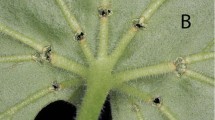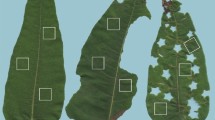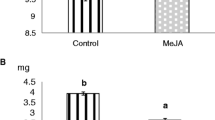Summary
Leaf damage significantly increases the alkaloid content in undamaged leaves on damaged field-grown wild tobacco plants. Although field-grown pot-bound plants fail to exhibit the same damage-induced increase in alkaloid content, the ability to respond to leaf damage is restored 6 days after removing plants from their pots. Freshly hatched Manduca sexta larvae reared individually in the laboratory on the high-alkaloid foliage of damaged plants released from their pots gain less weight and eat less (57.2% and 45.7% of controls, respectively) than larvae fed low-alkaloid foliage from undamaged released plants. Moreover, larvae grow equally well on the foliage of damaged and undamaged pot-bound plants. The higher chlorophyll contents characteristic of damaged released plants did not negate the effects of the increased alkaloid contents on larval growth. Undamaged leaves from undamaged field-grown plants stem-fed nicotine solutions had elevated leaf nicotine and nornicotine contents. Larvae reared on these artificially induced leaves gain only 38.5% of the weight gained by larvae reared on low-alkaloid foliage. These results demonstrate that damage-induced increases in leaf alkaloids protect induced foliage from attack and are sufficient to explain the decreased growth of caterpillars on the foliage of damaged plants.
Similar content being viewed by others
References
Baldwin IT (1988) Damage-induced alkaloids in tobacco: pot-bound plants are not inducible. J Chem Ecol (in press)
Barbosa P, Saunders JA (1985) Plant allelochemicals: linkages between herbivores and their natural enemies. In: Cooper Driver GA, Swain T, Conn EE (eds) Chemically Mediated Interactions between Plants and Other Organisms. NY Plenum Pub., pp 107–137
Dawson RF (1942) Accumulation of nicotine in reciprocal grafts of tomato and tobacco. Am J Bot 29:66–71
Feeny PP (1976) Plant apparency and chemical defense. In: Wallace J, Mansell RL (eds) Biochemical Interactions between Plants and Insects: Recent Advances in Phytochemistry 10:1–40
Fowler SV, Lawton JH (1985) Rapidly induced defenses and talking trees; the Devil's advocated position. Am Nat 126:181–195
Green TR, Ryan CA (1972) Wound-induced proteinase inhibitors in plant leaves: a possible defense mechanism against insects. Science 175:776–777
Guthrie FE, Hodgson E (1968) Adaptations of insects to nornicotine. Annals of the Entom Soc of Am 61:545–547
Hoffman JD, Lawson FR, Yamamoto RT (1966) Tobacco Hornworms. In: Smith CH (ed) Insect Colonization and Mass Production. NY Academic Press, p 618
Holden M (1965) Chlorophylls. In: Goodwin TW (ed) Chemistry and Biochemistry of Plant Pigments. London Academic Press pp 462–488
McNaughton SJ, Tarrants JL (1983) Grass leaf silicification: Natural selection for an inducible defense against herbivores. Proc Natl Acad Sci. USA 80:790–791
Parr JC, Thurston R (1972) Toxicity of nicotine in synthetic diets to larvae of the tobacco hornworm. Ann Entomol Soc Am 65:1158–1188
Rhoades DF (1979) Evolution of plant chemical defense against herbivores. In: Rosenthal GA, Janzen DH (eds) Herbivores: Their Interactions with Secondary Plant Compounds. NY Academic Press, pp 4–54
Schultz JC, Baldwin IT (1982) Oak leaf quality declines in response to defoliation by gypsy moth larvae. Science 217:149–151
Self LS, Guthrie EF, Hodgson E (1964) Adaptation of tobacco hornworms to the ingestion of nicotine. J Insect Physiol 10:907–914
Sokal RR, Rohlf FJ (1981) Biometry. San Francisco, WH Freeman & Co., p 400
Tso TC (1972) Physiology and Biochemistry of Tobacco Plants. Stroudsberg, PA, Dowden, Hutchinson and Ross, p 245
Valentine HT, Wallner WE, Wargo PM (1983) Nutritional changes in host foliage during and after defoliation, and their relation to the weight of gypsy moth pupae. Oecologia (Berlin) 57:298–302
Wagner MR, Evans PD (1985) Defoliation increases nutritional quality and allelochemics of pine seedlings. Oecologia (Berlin) 67:235–237
Williams KS, Myers JH (1984) Previous herbivore attack of red alder may improve food quality for fall webworm larvae. Oecologia (Berlin) 63:166–170
Wong PP, Kuo T, Ryan CA, Kado CI (1976) Differential accumulation of proteinase inhibitor I in normal and crown gall tissue of tobacco, tomato and potato. Plant Physiol 57:214–217
Author information
Authors and Affiliations
Rights and permissions
About this article
Cite this article
Baldwin, I.T. Short-term damage-induced increases in tobacco alkaloids protect plants. Oecologia 75, 367–370 (1988). https://doi.org/10.1007/BF00376939
Received:
Issue Date:
DOI: https://doi.org/10.1007/BF00376939




